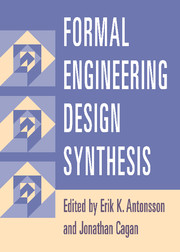Book contents
- Frontmatter
- Contents
- Contributing Authors
- Foreword
- Preface
- Introduction
- 1 Vitruvius Redux
- 2 How to Calculate with Shapes
- 3 Engineering Shape Grammars
- 4 Creating Structural Configurations
- 5 Microsystem Design Synthesis
- 6 Function-Based Synthesis Methods in Engineering Design
- 7 Artificial Intelligence for Design
- 8 Evolutionary and Adaptive Synthesis Methods
- 9 Kinematic Synthesis
- 10 Systematic Chemical Process Synthesis
- 11 Synthesis of Analog and Mixed-Signal Integrated Electronic Circuits
- 12 Mechanical Design Compilers
- 13 Scientific Discovery and Inventive Engineering Design
- Index
9 - Kinematic Synthesis
Published online by Cambridge University Press: 10 October 2009
- Frontmatter
- Contents
- Contributing Authors
- Foreword
- Preface
- Introduction
- 1 Vitruvius Redux
- 2 How to Calculate with Shapes
- 3 Engineering Shape Grammars
- 4 Creating Structural Configurations
- 5 Microsystem Design Synthesis
- 6 Function-Based Synthesis Methods in Engineering Design
- 7 Artificial Intelligence for Design
- 8 Evolutionary and Adaptive Synthesis Methods
- 9 Kinematic Synthesis
- 10 Systematic Chemical Process Synthesis
- 11 Synthesis of Analog and Mixed-Signal Integrated Electronic Circuits
- 12 Mechanical Design Compilers
- 13 Scientific Discovery and Inventive Engineering Design
- Index
Summary
INTRODUCTION
This chapter surveys recent results in the kinematic synthesis of machines. A machine is generally considered to be a device that directs a source of power to a desired application of forces and movement. The earliest machines were simply wedges, levers, and wheels that amplified human and animal effort. Eventually wind and water power were captured to drive gearing that rotated millstones and pumps (Dimarogonas, 1993). Today chemical, nuclear, hydroelectric, and solar energy drive machines that build, manufacture, transport, and process items that affect all aspects of our lives.
Kinematic synthesis determines the configuration and size of the mechanical elements that shape this power flow in a machine. In this chapter we show how researchers in machine design and robotics use the concepts of workspace and mechanical advantage as the criteria for the kinematic synthesis of a broad range of machines.
The workspace of a machine part is the set of positions and orientations that it can reach. We will see that there are many representations of this workspace; however, the best place to start is with the kinematics equations of the chain of bodies that connect the part to the base frame. The range of values of the configuration parameters that appear in these kinematics equations defines the configuration space of the system. The velocity of the part is then obtained by computing the Jacobian of these kinematics equations in terms of the rate of change of these configuration parameters.
Information
- Type
- Chapter
- Information
- Formal Engineering Design Synthesis , pp. 321 - 361Publisher: Cambridge University PressPrint publication year: 2001
Accessibility standard: Unknown
Why this information is here
This section outlines the accessibility features of this content - including support for screen readers, full keyboard navigation and high-contrast display options. This may not be relevant for you.Accessibility Information
- 7
- Cited by
